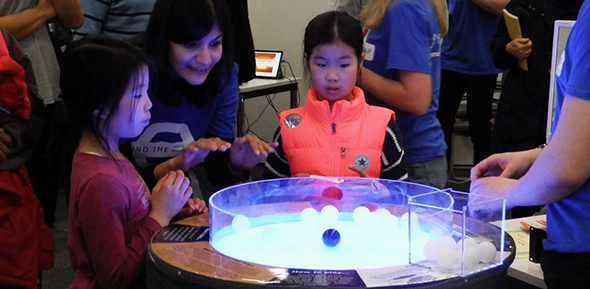The Cambridge Centre for Doctoral Training in Nanoscience and Nanotechnology has been selected to showcase its cutting-edge biosensing research at the Royal Society Summer Science Exhibition.
There will be a number of exciting hands-on demos at our exhibit covering nanopores, atomically thin membranes, and the tiny gaps between nanostructures that are just billionths of a metre wide.
Professor of Nanotechnology Stephan Hofmann
Running next week (Monday 2 July – Sunday 8 July), Mind the (nano) Gap is one of 22 exhibits celebrating the science that’s shaping our future.
It focuses on detecting bio-molecules like DNA from their unique signatures as they interact with nanoscale gaps. By pulling molecules of interest into the small space – or nanogap – between tiny sensor components, they now become visible to the instruments used to measure them. Various techniques exist to do this using nanopores, atomically thin membranes, or tiny gaps between nanostructures that are just billionths of a metre wide.
The hands-on exhibit will include:
- An experiment with plasma balls to understand nanogap sensing with lasers
- The use of an air tower to mimic the sensing of molecules through a nanopore
- An opportunity to interactively experience how we can sense molecules via mass and charge with an active nano-membrane.
Professor of Nanotechnology Stephan Hofmann said: “In healthcare, it is critical to be able to measure traces of molecules with great accuracy in order to diagnose or monitor the progression of diseases, check for allergens in food, or for drug testing. There will be a number of exciting hands-on demos at our exhibit covering nanopores, atomically thin membranes, and the tiny gaps between nanostructures that are just billionths of a metre wide.”
Dr Giuliana Di Martino, who co-ordinated the organisation of the event, said: “Just like we have different senses to perceive the world around us – sight, smell, taste, touch – we need different sensors to solve the puzzle of which bio-molecules we're dealing with. In our exhibit, we show how nanogaps in gold nanoparticles, graphene and nanopores can sense mass, electrical charge, size and composition of molecules. By implementing these really sensitive techniques in our futuristic Intelligent Toilet – which you will see in our stand – we will be able, in the future, to detect even really tiny amounts of specific biomarkers in our urine, leading to better and personalised healthcare directly into our homes.”
Postdoctoral Research Associate Nicole Weckman, who has helped to build and will be demonstrating the nanopore exhibit, added: “Many interesting and important biological molecules like DNA and proteins are very small, too small to be seen using a normal microscope. Scientists and engineers are constantly inventing new sensors to improve our ability to see and measure these small molecules, often taking advantage of unique nanoscale phenomena. As these detection technologies improve and become faster and more affordable, they have the potential to make a big impact in areas like healthcare where they can help us monitor our health in a personalised way. Visit our website or check out our exhibit to find out more!”

Credit: Kimberly Cole
About NanoDTC
Research at the Cambridge Centre for Doctoral Training in Nanoscience and Nanotechnology covers a vast range of topics including batteries, solar cells, fuel cells, hardware for advanced computing technologies, innovative manufacturing technologies, new therapeutics and biosensing.

